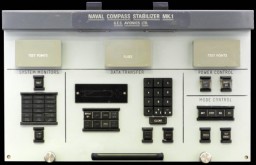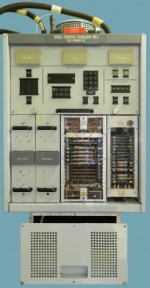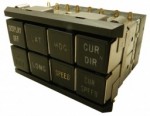The Naval Compass Stabiliser NCS1 is a stabilised gyrocompass system designed to provide heading and vertical reference data for systems that use such data, on board a ship. Development of NCS1 started in 1971 and quantity production was underway by 1976 with 80 systems delivered to British and other Navies by 1984. NCS1 provides as standard outputs of Heading, Pitch, and Roll but with an additional card can give own ship acceleration and velocity. The ships Latitude and Longitude are continuously computed.
There are three major units; Space Reference Unit (SRU), Electronic Pack (EP) and a Resilient Mount Assembly (RMA).
The SRU comprises a stabilised platform containing 2 two axis gyroscopes and 2 single axis accelerometers mounted in a gimbal system which is contained in a closed binnacle with associated control electronics.
The RMA is used in frigates and submarines and basically supports the SRU but importantly protects it against vibration from the ship and from shock up to 190g. In addition the RMA transmits the ships acceleration and attitude to the SRU and provides the facility for aligning the SRU with the ship datum planes. In fast Patrol Boats and vessels where any potential shock is likely to be much lighter (typically <15g) a lightweight mount assembly, the LMA, is used.
The EP contains a Digital Computer, Interface Unit, Control /Indicator Panel, Power Inverters and a Standby Battery. The computer is the 12/12P which was a product of the Airborne Computing Division at Rochester (with a part number 59-018-02). The 12/12P was probably the first production version of the 12 series to be introduced, in 1973. It had a 4K, 2 microsecond, core memory and instruction times very similar to those of the Elliott 102C/Minim. The Interface Unit carries out such functions as synchro digital conversion, analogue to digital conversion and the reverse, signal buffering and built-in test. A Control and Indicator panel hosts switches and displays to select the mode of operation, set in information, display selected outputs and enable computer controlled or manual testing.
The Transformer Rectifier units convert ship’s power to 28v dc and in the event of a supply failure the 24V standby battery will support the system for 30minutes. Two identical controlled inverters produce all the regulated dc supplies required by NCS1. The EP has a cooling fan driven by a separate power supply and there is a heater in the base to prevent condensation when the equipment is switched off.
All the items in the NCS1 have a Nato Stock Number inscribed and also have a five digit 'CD' number.
Initial sea trials were carried out in HMS Antrim and the system entered service in 1977 and was accepted in 1981; it then went into later construction Type 22 and 42.
NCS1 was designed and manufactured within the Guidance Systems Division at Rochester between 1976 and possibly beyond 1984. NCS1 is likely to be in-service until somewhere between 2015 and 2035.
The NCS1 is a tall unit and there is a story that in order to calibrate the system using the Pole Star that a hole had to be cut in the roof of the clean room test area!







